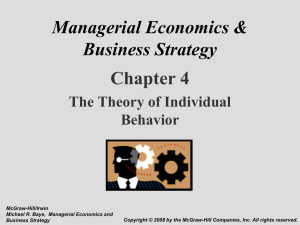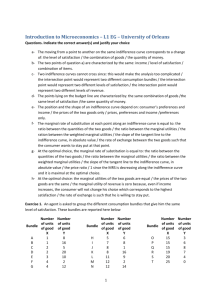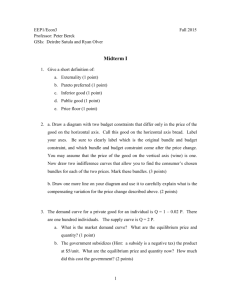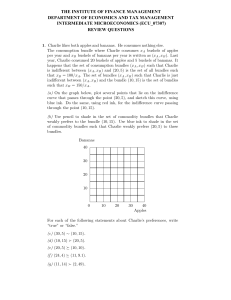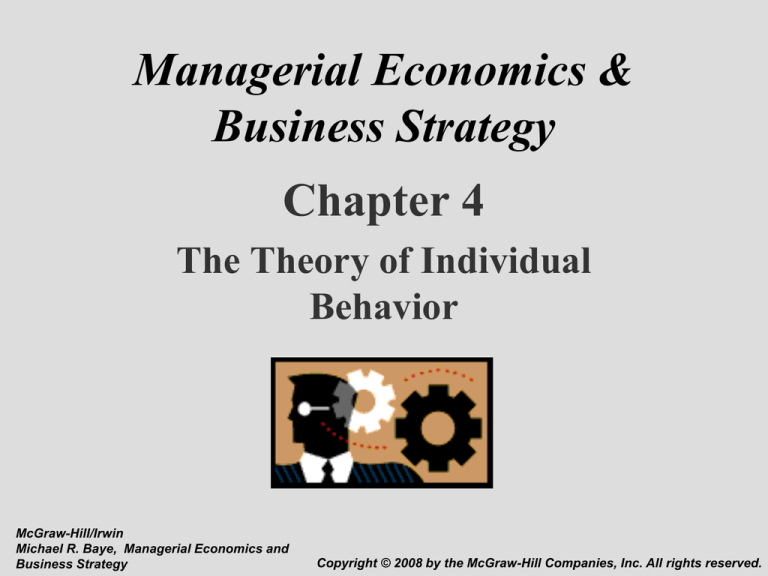
Managerial Economics &
Business Strategy
Chapter 4
The Theory of Individual
Behavior
McGraw-Hill/Irwin
Michael R. Baye, Managerial Economics and
Business Strategy
Copyright © 2008 by the McGraw-Hill Companies, Inc. All rights reserved.
Overview
I. Consumer Behavior
Indifference Curve Analysis
Consumer Preference Ordering
II. Constraints
The Budget Constraint
Changes in Income
Changes in Prices
III. Consumer Equilibrium
IV. Indifference Curve Analysis & Demand Curves
Individual Demand
Market Demand
4-2
4-3
Consumer Behavior
• Consumer Opportunities
The possible goods and services consumer can afford to
consume.
• Consumer Preferences
The goods and services consumers actually consume.
• Given the choice between 2 bundles of
goods a consumer either
Prefers bundle A to bundle B: A B.
Prefers bundle B to bundle A: A B.
Is indifferent between the two: A B.
4-4
Indifference Curve Analysis
Indifference Curve
A curve that defines the
combinations of 2 or more goods
that give a consumer the same
level of satisfaction.
Good Y
III.
II.
I.
Marginal Rate of
Substitution
The rate at which a consumer is
willing to substitute one good for
another and maintain the same
satisfaction level.
Good X
Consumer Preference Ordering
Properties
•
•
•
•
Completeness
More is Better
Diminishing Marginal Rate of Substitution
Transitivity
4-5
4-6
Complete Preferences
• Completeness Property
Consumer is capable of
expressing preferences (or
indifference) between all possible
bundles. (“I don’t know” is NOT
an option!)
• If the only bundles available
to a consumer are A, B, and
C, then the consumer
– is indifferent between A and
C (they are on the same
indifference curve).
– will prefer B to A.
– will prefer B to C.
Good Y
III.
II.
I.
A
B
C
Good X
4-7
More Is Better!
• More Is Better Property
Bundles that have at least as much of
every good and more of some good
are preferred to other bundles.
• Bundle B is preferred to A since
B contains at least as much of
good Y and strictly more of good
X.
• Bundle B is also preferred to C
since B contains at least as much
of good X and strictly more of
good Y.
• More generally, all bundles on
ICIII are preferred to bundles on
ICII or ICI. And all bundles on
ICII are preferred to ICI.
Good Y
III.
II.
I.
100
A
B
C
33.33
1
3
Good X
Diminishing Marginal Rate of
Substitution
4-8
• Marginal Rate of Substitution
The amount of good Y the consumer is
willing to give up to maintain the same
satisfaction level decreases as more of
good X is acquired.
The rate at which a consumer is willing to
substitute one good for another and
maintain the same satisfaction level.
Good Y
• To go from consumption bundle A to
B the consumer must give up 50 units 100
of Y to get one additional unit of X.
• To go from consumption bundle B to
C the consumer must give up 16.67
50
units of Y to get one additional unit of
33.33
X.
25
• To go from consumption bundle C to
D the consumer must give up only
8.33 units of Y to get one additional
unit of X.
III.
II.
I.
A
B
C
1
2
3
D
4
Good X
4-9
Consistent Bundle Orderings
• Transitivity Property
Good Y
For the three bundles A, B, and C,
the transitivity property implies
that if C B and B A, then C
A.
Transitive preferences along with
the more-is-better property imply 100
75
that
• indifference curves will not
50
intersect.
• the consumer will not get
caught in a perpetual cycle of
indecision.
III.
II.
I.
A
C
B
1
2
5
7 Good X
4-10
The Budget Constraint
• Opportunity Set
The set of consumption bundles
that are affordable.
• PxX + PyY M.
Y
The Opportunity Set
Budget Line
M/PY
Y = M/PY – (PX/PY)X
• Budget Line
The bundles of goods that exhaust a
consumers income.
• PxX + PyY = M.
• Market Rate of Substitution
The slope of the budget line
• -Px / Py
M/PX
X
4-11
Changes in the Budget Line
Y
• Changes in Income
Increases lead to a parallel,
outward shift in the budget
line (M1 > M0).
Decreases lead to a parallel,
downward shift (M2 < M0).
M1/PY
M0/PY
M2/PY
• Changes in Price
Y
A decreases in the price of
good X rotates the budget
M0/PY
line counter-clockwise (PX0 >
PX1).
An increases rotates the
budget line clockwise (not
shown).
M2/PX
M0/PX
M1/PX
X
New Budget Line for
a price decrease.
M0/PX0
M0/PX1
X
4-12
Consumer Equilibrium
• The equilibrium
consumption bundle is
the affordable bundle
that yields the highest
level of satisfaction.
Consumer equilibrium
occurs at a point where
MRS = PX / PY.
Equivalently, the slope of
the indifference curve
equals the budget line.
Y
M/PY
Consumer
Equilibrium
III.
II.
I.
M/PX
X
Price Changes and Consumer
Equilibrium
• Substitute Goods
An increase (decrease) in the price of good X leads to
an increase (decrease) in the consumption of good Y.
• Examples:
– Coke and Pepsi.
– Verizon Wireless or AT&T.
• Complementary Goods
An increase (decrease) in the price of good X leads to a
decrease (increase) in the consumption of good Y.
• Examples:
– DVD and DVD players.
– Computer CPUs and monitors.
4-13
4-14
Complementary Goods
When the price of
Pretzels (Y)
good X falls and the
consumption of Y
rises, then X and Y M/PY
1
are complementary
goods. (PX1 > PX2)
B
Y2
II
A
Y1
I
0
X1 M/PX1
X2
M/PX2
Beer (X)
Income Changes and Consumer
Equilibrium
• Normal Goods
Good X is a normal good if an increase (decrease) in
income leads to an increase (decrease) in its
consumption.
• Inferior Goods
Good X is an inferior good if an increase (decrease) in
income leads to a decrease (increase) in its
consumption.
4-15
4-16
Normal Goods
An increase in
income increases
the consumption of
normal goods.
Y
M1/Y
(M0 < M1).
B
Y1
M0/Y
II
A
Y0
I
0
X0 M0/X
X1
M1/X
X
4-17
Decomposing the Income and
Substitution Effects
Initially, bundle A is consumed.
A decrease in the price of good
X expands the consumer’s
opportunity set.
Y
C
The substitution effect (SE)
causes the consumer to move
from bundle A to B.
A
II
A higher “real income” allows
the consumer to achieve a
higher indifference curve.
The movement from bundle B to
C represents the income effect
(IE). The new equilibrium is
achieved at point C.
B
I
0
IE
SE
X
4-18
A Classic Marketing
Application
Other
goods
(Y)
A buy-one,
get-one free
pizza deal.
A
C
E
D
II
I
0
0.5
1
2
B
F
Pizza
(X)
4-19
Individual Demand Curve
Y
• An individual’s
demand curve is
derived from each new
equilibrium point
found on the
indifference curve as
the price of good X is
varied.
II
I
X
$
P0
D
P1
X0
X1
X
4-20
Market Demand
• The market demand curve is the horizontal
summation of individual demand curves.
• It indicates the total quantity all consumers would
purchase at each price point.
$
Individual Demand
Curves
$
Market Demand Curve
50
40
D1
1 2
D2
Q
1 2 3
DM
Q
4-21
Conclusion
• Indifference curve properties reveal information
about consumers’ preferences between bundles of
goods.
Completeness.
More is better.
Diminishing marginal rate of substitution.
Transitivity.
• Indifference curves along with price changes
determine individuals’ demand curves.
• Market demand is the horizontal summation of
individuals’ demands.

